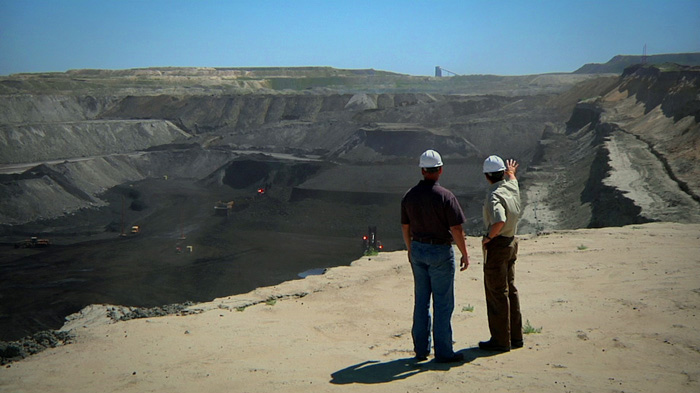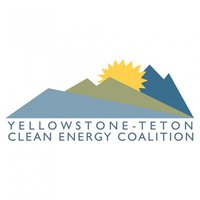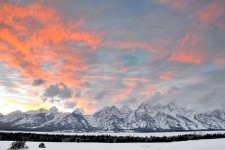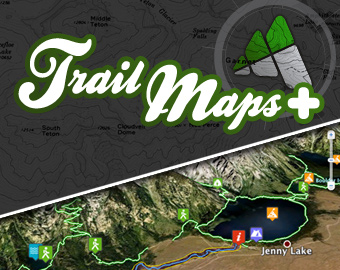Hundred Days
Reflections on the Wyoming Premiere of Switch

06/19/12 – Reflections on the Wyoming Premiere of Switch
Written By: Kevin Wittig @kevinswittig
How can we maintain the benefits of oil and coal without the by-products and also make it affordable? That’s the question Harry Lynch, director of the new film “Switch“, asked a crowded theater at the National Museum of Wildlife Art. Switch features renowned geologist and University of Texas professor Dr. Scott Tinker and follows his journey around the world in pursuit of the sources for future energy demand. The film is being distributed to universities, non-profits and governments in hopes to educate audiences with unbiased facts.
The Wyoming Premiere of “Switch”
Film Description: What will it really take, to switch from oil and coal to other alternatives? In the film “Switch,“ Dr. Scott Tinker, Director of the Bureau of Economic Geology embarks on a round-the-world journey to answer this and related questions. If coal is dirty, why do we keep using it? Can we really clean it up? Will oil get more expensive? Will it run out? How quickly will we adopt alternatives, and which ones? How risky is hydraulic fracturing? How dangerous is nuclear?
Director Harry Lynch Visited Jackson Hole For The Wyoming Premiere

Switch uses excellent cinematography in a well organized format to creatively educate and entertain audiences using real world scenarios that provoke thought. The film visits India, the tar sands of Canada, remote oil platforms, wind farms in Texas and alternative energy productions sites around the world to expose the truths and myths about how we consume and create energy.
After the film, Lynch answered questions, and spoke about his experience making Switch, his sixth production. His point: Energy is the most important issue of our time. It impacts the economy, the environment, food and water, population, everything. To help others understand these challenges, we first need to understand energy.
Take Aways From The Film
Wyoming Coal

- It was grounding to learn that coal powers 50% of the U.S. and that 25% of that comes from the Powderhorn Basin in Wyoming. The economics for coal are undeniable. It’s cheap! To move forward with coal, clean carbon technology is mandatory, but it’s not affordable to make coal clean. We’ll have to innovate.
Natural Gas

- Natural gas produces low emissions, water vapor, no smoke, and is a very clean fuel. The initial cost to acquire compression and storage equipment is high, and it currently makes economic sense for large vehicle fleets, like bus services.
- If fleets around the country converted to natural gas, we would make a difference in emissions output. Not a complete replacement for oil, but a strong supplement.
Oil

- Oil has the biggest impact on the economy, both macro and micro. As supply and demand dictates price, oil companies will pursue more remote reserves, particularly offshore. Gasoline is a miracle accelerant that is efficient and leaves no residue. It will be very difficult to replace.
- The U.S. consumes one supertanker of oil every 45 minutes. This will become very expensive in the future.
Wind

- The main point taken way is that wind energy is a supplement. It will never replace other sources, because wind is intermittent, but can be used to augment output from other sources.
- Faces challenges from the “not in my backyard” mentality
Hydro Electric

- The Teton Region is powered by hydro electricity. When the logistics are right, hydro serves as a great power source. Norway has constructed the most advanced hydro electric power systems on the planet, but few countries can rely solely on hydro.
Solar

- High upfront cost with an eight to ten year payback. Expensive maintenance coupled with low energy production inhibits the economics. We are decades away from making the economics work and new technology to store energy output.
- Limited in areas of production
Ways We Can Make A Difference In The Teton Region
It’s easy to want to save the environment when we live next to a National Park. Through education and awareness, we can all do our part to help and share our mentality with the world. To start, check out the following non-profits in the region and learn how you can help.

The goals of the Jackson Hole Energy Sustainability Project are to make Jackson Hole into a world class showcase of energy efficiency and to save every single person in this community money on their utility bill at the same time. Simple things people can do include energy audits and increase energy efficiency measures that create cost savings. Learn more about financial incentives on their website.

This non-profit promotes fuels, technologies and strategies to lessen our reliance on petroleum. The coalition’s collective mission is to displace the use of petroleum in the transportation sector, improve air quality through reduced harmful exhaust emissions and increase U.S. energy security.
Stay up to date with their active posts on Facebook and events throughout the summer in the community.

“Every person in America should see and digest this film” – Doug Johnson, Statoil
Other Posts from The Mountain Pulse
Tweet
!function(d,s,id){var js,fjs=d.getElementsByTagName(s);if(!d.getElementById(id)){js=d.createElement(s);js.id=id;js.src="//platform.twitter.com/widgets.js";fjs.parentNode.insertBefore(js,fjs);}}(document,"script","twitter-wjs");
02/18/14 - A break in the storm reveals the sight that never gets old, a breathtaking sunset in Grand Teton Nation Park. Photographer: Stephen Williams
Previous Photos
Read More
Tweet
!function(d,s,id){var js,fjs=d.getElementsByTagName(s);if(!d.getElementById(id)){js=d.createElement(s);js.id=id;js.src="//platform.twitter.com/widgets.js";fjs.parentNode.insertBefore(js,fjs);}}(document,"script","twitter-wjs");
The 43rd Annual Shriner's Cutter Races
Previewed By: Adam Glos
Saturday, February 15th // Sunday, February 16th
Melody Ranch // Jackson, WY
12:00 pm – 3:00 pm
General Admission: $15
This weekend, give your ski ...
Read More
Tweet
!function(d,s,id){var js,fjs=d.getElementsByTagName(s);if(!d.getElementById(id)){js=d.createElement(s);js.id=id;js.src="//platform.twitter.com/widgets.js";fjs.parentNode.insertBefore(js,fjs);}}(document,"script","twitter-wjs");
The 2014 Banff Mountain Film Festival World Tour
Sponsored By: Skinny Skis
Previewed By: Adam Glos
Saturday, Feb. 8th / 8 pm // Sunday, Feb 9th / 7 pm
Jackson Hole High School ...
Read More
Tweet
!function(d,s,id){var js,fjs=d.getElementsByTagName(s);if(!d.getElementById(id)){js=d.createElement(s);js.id=id;js.src="//platform.twitter.com/widgets.js";fjs.parentNode.insertBefore(js,fjs);}}(document,"script","twitter-wjs");
Moon Taxi
Previewed By: Ellie Stratton-Brook
Saturday January, 25th
Pink Garter Theatre // Jackson, WY
With special guests the Acoustic Weapons
Doors - 8:00pm // Show - 9:00pm
Tickets: $14 in advance // Buy Tickets ...
Read More
Tweet
!function(d,s,id){var js,fjs=d.getElementsByTagName(s);if(!d.getElementById(id)){js=d.createElement(s);js.id=id;js.src="//platform.twitter.com/widgets.js";fjs.parentNode.insertBefore(js,fjs);}}(document,"script","twitter-wjs");
2014 Coldsmoke Awards
Previewed By: Stephen Williams
Saturday January, 18th
Emerson Cultural Center, Bozeman MT
North of the Sun - Filmhuset AS
Never Not Part 2 - Nike
Valhalla - Sweetgrass Productions
Previous Photos
Read More
Tweet
!function(d,s,id){var js,fjs=d.getElementsByTagName(s);if(!d.getElementById(id)){js=d.createElement(s);js.id=id;js.src="//platform.twitter.com/widgets.js";fjs.parentNode.insertBefore(js,fjs);}}(document,"script","twitter-wjs");
Warren Miller's Ticket to Ride
Previewed By: Stephen Williams
Friday December, 20th
Pink Garter Theatre
All Ages Showing - 6:00 pm
21+ Showing - 9:00pm
$16 / Buy Tickets Online
Read More
Avalanche Awareness Night
Thursday 12/05 - 6:30 to 9:30pm
Jackson Hole Center for the Arts
$5 Donation benefits Teton County Search and Rescue
Previewed by: Stephen Williams
From the time that Powder Magazine's annual Buyer's ...
Read More
Tweet
!function(d,s,id){var js,fjs=d.getElementsByTagName(s);if(!d.getElementById(id)){js=d.createElement(s);js.id=id;js.src="//platform.twitter.com/widgets.js";fjs.parentNode.insertBefore(js,fjs);}}(document,"script","twitter-wjs");
03/20/14 - Spring is right around the corner and with such a high snowpack in Jackson Hole, the touring season will be awesome. Doug Hayden, Kevin Salys and Tyler ...
Read More
Tweet
!function(d,s,id){var js,fjs=d.getElementsByTagName(s);if(!d.getElementById(id)){js=d.createElement(s);js.id=id;js.src="//platform.twitter.com/widgets.js";fjs.parentNode.insertBefore(js,fjs);}}(document,"script","twitter-wjs");
03/15/14 - What a perfect day to be in the mountains. Fresh snow, clear sunny skies and just a little wind. Alex Howell takes a moment to take in ...
Read More
Tweet
!function(d,s,id){var js,fjs=d.getElementsByTagName(s);if(!d.getElementById(id)){js=d.createElement(s);js.id=id;js.src="//platform.twitter.com/widgets.js";fjs.parentNode.insertBefore(js,fjs);}}(document,"script","twitter-wjs");
03/11/14 - Springtime pow surfing with Kyle Martin from Dragon Alliance as he rips into 13" of new snow under bluebird skies at Grand Targhee Resort. Photographer: Kevin Cass ...
Read More
Tweet
!function(d,s,id){var js,fjs=d.getElementsByTagName(s);if(!d.getElementById(id)){js=d.createElement(s);js.id=id;js.src="//platform.twitter.com/widgets.js";fjs.parentNode.insertBefore(js,fjs);}}(document,"script","twitter-wjs");
03/10/14 - 2nd Annual Ski Joring Championships
Written and Photographed By: Stephen Williams
Ski Joring is an event with a perfect mix of Jackson Hole's historic cowboy culture and the new ...
Read More
Tweet
!function(d,s,id){var js,fjs=d.getElementsByTagName(s);if(!d.getElementById(id)){js=d.createElement(s);js.id=id;js.src="//platform.twitter.com/widgets.js";fjs.parentNode.insertBefore(js,fjs);}}(document,"script","twitter-wjs");
Canyon Kids Release Double EP
Written By: Adam Glos
Photos by: Christie Quinn
In case you missed it, the debut album from Canyon Kids hit the electronic shelves recently, proving once again ...
Read More
Tweet
!function(d,s,id){var js,fjs=d.getElementsByTagName(s);if(!d.getElementById(id)){js=d.createElement(s);js.id=id;js.src="//platform.twitter.com/widgets.js";fjs.parentNode.insertBefore(js,fjs);}}(document,"script","twitter-wjs");
<
Head for the Hills
Previewed By: Ellie Stratton-Brook
Thursday March, 6th
Town Square Tavern // Jackson, WY
9:00pm // Tickets: $10 // Buy Tickets Online
Although you may have seen many bluegrass bands around ...
Read More
Tweet
!function(d,s,id){var js,fjs=d.getElementsByTagName(s);if(!d.getElementById(id)){js=d.createElement(s);js.id=id;js.src="//platform.twitter.com/widgets.js";fjs.parentNode.insertBefore(js,fjs);}}(document,"script","twitter-wjs");
03/02/14 - Mark Byall slashes a line in the Jackson Hole Mountain Resort backcountry as the consistent flow of snow continues into March. Photographer: Stephen Williams
Previous Photos
Read More
Tweet
!function(d,s,id){var js,fjs=d.getElementsByTagName(s);if(!d.getElementById(id)){js=d.createElement(s);js.id=id;js.src="//platform.twitter.com/widgets.js";fjs.parentNode.insertBefore(js,fjs);}}(document,"script","twitter-wjs");
02/23/24 - A skier flies off a jump being pulled behind a horse racing down a track at Melody Ranch just south of Jackson for the 2nd Annual Ski ...
Read More
Tweet
!function(d,s,id){var js,fjs=d.getElementsByTagName(s);if(!d.getElementById(id)){js=d.createElement(s);js.id=id;js.src="//platform.twitter.com/widgets.js";fjs.parentNode.insertBefore(js,fjs);}}(document,"script","twitter-wjs");
02/22/14 - February has been incredible in Jackson Hole and it's not quite over yet. Marian Herbick digs into the bottom half of Four Pjnes with more fresh snow ...
Read More
Tweet
!function(d,s,id){var js,fjs=d.getElementsByTagName(s);if(!d.getElementById(id)){js=d.createElement(s);js.id=id;js.src="//platform.twitter.com/widgets.js";fjs.parentNode.insertBefore(js,fjs);}}(document,"script","twitter-wjs");
02/21/14 - Nick Grenoble left his snorkel at home and had to come up for air between trips to the whiteroom. Jackson Hole Mountain Resort was unbelievably deep today ...
Read More
Tweet
!function(d,s,id){var js,fjs=d.getElementsByTagName(s);if(!d.getElementById(id)){js=d.createElement(s);js.id=id;js.src="//platform.twitter.com/widgets.js";fjs.parentNode.insertBefore(js,fjs);}}(document,"script","twitter-wjs");
The 2nd Annual North American Skijoring Championships
Previewed By: Adam Glos
Saturday, February 22nd - 12:00pm
1 Sunday, February 23rd - 11:00am
Melody Ranch // Jackson, WY
General Admission: $10 // Kids 12 and ...
Read More












































